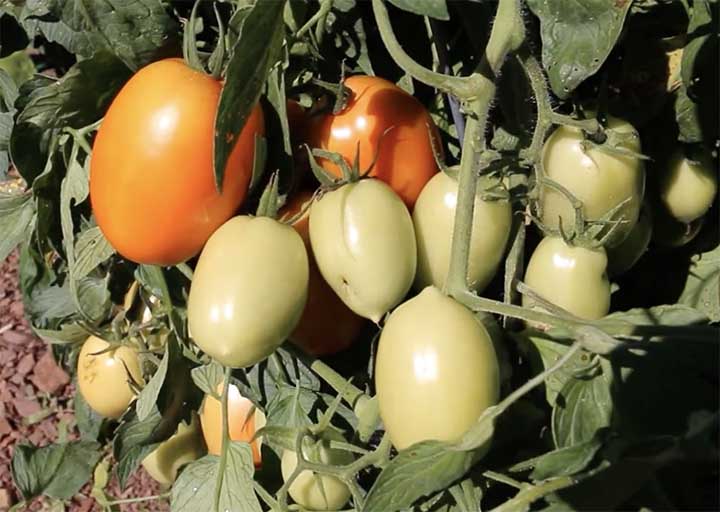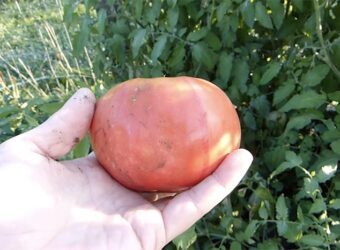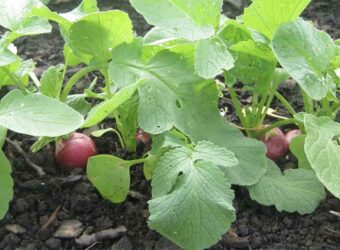Tomatoes are delicious when they are homegrown. Roma-type tomatoes are ideal for canning and making sauce. If you want to grow your own cooking ingredients, this is a good tomato to grow.
Quick Growing Guide for the Roma-Type Tomato
| Plant Type | Mostly Determinate | Resistant to | varies |
| USDA Hardiness Zone | 3-9 | Maintenance | Moderate to High |
| Season | Summer, early fall | Soil Type | Fertile, well aerated |
| Exposure | Full Sun | Soil pH | 6.2-6.8 |
| Time to Maturity | 70-90 days | Soil Drainage | Well-drained |
| Water Needs | Moderate | Companion Plants | Lettuce, basil, beets |
| Planting Depth | ¼ inch deep | Don’t Plant Near | Potatoes, peppers, eggplants |
| Spacing | 2-3 feet | Family | Solanaceae |
| Height | 3-6 feet | Genus | Solanum |
| Spread | 2-4 feet | Species | lycopersicum |
| Common Pests and Diseases | varies | Variety |
What Is a Roma Tomato?
A Roma tomato is a variety of paste tomatoes. However, this article discusses Roma-type tomatoes, which are any tomatoes primarily used for paste, sauce, or canned whole or in part.
Cultivation and History
Roma-type tomatoes were developed originally in Italy. After they were imported to the United States, Roma-type tomatoes were used in canning. Some new types of Roma-type tomatoes, including the Roma variety, were developed from Italian paste tomatoes.
Characteristics of the Roma Tomato
Growth Habit
Most Roma-type tomatoes are determinate. They all ripen within 1-3 weeks, making it easy to gather enough for a batch of sauce or canning at one time. Some paste tomatoes, like the San Marzano tomato, are indeterminate.
Fruit Size, Color, Texture, Taste
Roma-type tomatoes are generally egg-shaped and range from three to six inches in size. They are generally red, although some orange and yellow varieties have been developed. The tomatoes are meaty, sweet, and have a distinct seed capsule that is easy to remove.
Tomato Types
Some are open-pollinated, and some are hybrids.
Plant Resistance
Resistance varies by the variety of Roma-type tomatoes.
Common Roma Type Tomatoes
Here are some of the most common Roma-type tomatoes.
San Marzano tomatoes are indeterminate tomatoes from Italy. They take 80 days to produce a harvest.
Roma tomatoes are an heirloom tomato developed by scientists at the USDA in 1955. They take 75 days to produce a harvest.
Amish Paste tomatoes are an heirloom tomato believed to have come from an Amish community in Wisconsin in the 1800s. It is indeterminate and takes 80 days to produce a harvest.
Caring for the Roma Tomato
Roma-type tomatoes are not hard to care for. Here is what you need to know.
Light
I plant my Roma-type tomatoes in full sun. They do better with at least eight hours of sunlight a day. I live in a hot climate, so plant them where they get afternoon shade. If I can’t do that, I put shade cloth over them.
Soil
If you want to grow great tomatoes, you need a soil test. I do one every three years. A soil test tells you your soil pH and what nutrients are in your soil. In addition, the soil test report gives you recommendations for what fertilizer to spread before you plant your tomatoes. You can get supplies and instructions from your Extension agent or agricultural advisor.
Roma-type tomatoes grow best at a pH of 6.2-6.8. To prepare my soil for my tomato plants, I till the ground to a depth of six inches. I then spread three inches of compost over the tilled ground. I work the compost into the six inches of tilled soil. At this point, I take the soil samples for my soil test. When I get the report back, I fertilize the soil as the soil test recommends.
In the absence of a soil test, I suggest spreading four to five pounds of 10-10-10 fertilizer per 100 feet of row. If you want to know more detail about 10-10-10 fertilizer, read my article. If your soil is high in phosphorous and potassium, use 46-0-0 instead.
Planting
You can grow Roma-type tomatoes from seeds or transplants. I have found it is hard to find plants for many of these type of plants, so I tend to start mine from seeds. For complete instructions on starting seeds and planting transplants, see my article, “How to Grow Tomatoes – The Ultimate Guide.”
When to Plant Roma Tomatoes
Roma-type tomatoes need to be planted after all danger of frost has passed and the air temperature is at least 70 degrees. I have found that cold-stunted tomato plants never have as many tomatoes as ones that are not cold-stunted, so don’t plant them too early.
Water
Roma-type tomatoes need even soil moisture from transplant to when they stop producing. I have found uneven soil moisture causes blossom end rot. I use an inexpensive moisture meter to help me. Tomatoes need an inch of water a week until they set fruit, then need two inches of water a week. My climate is hot, so I water twice a week for the length of the plant’s life. If you live in a more temperate climate, water once a week until the fruit sets, then water twice a week.
Temperature
Roma-type tomatoes need temperatures of at least 70 degrees. I find tomato plants are very sensitive to frost, so planting them early is wasted. They won’t grow well or will die.
When the temperatures are over 90 degrees, the pollen in the flowers is rendered infertile and fruit won’t set. I pull the plants at this point. I have found plants nursed through the summer never produce as much in the fall as fresh plants.
Fertilizer
See the discussion of planting fertilizers under soil above. After the fruit sets, I start fertilizing every two weeks with a liquid fertilizer or every four weeks with a granular fertilizer designed for tomatoes. For more on fertilizing tomatoes, read my article.
Pruning
Most Roma-type tomatoes are determinate, so they should not be pruned. For the ones that are indeterminate, I prune when the first flower cluster blooms. I remove the suckers by the base of the plant. I then remove the suckers in the space where a branch meets the stem, except for the last sucker before the flower cluster.
Why Plant Roma Tomatoes?
Roma-type tomatoes are great for making tomato sauce, canning, and making tomato paste. Their flavor stands up to processing well, they have an easily removed seed capsule, and they come off the plant all at once.
Where to Buy Roma Tomatoes
Roma-type tomatoes are readily available from nurseries and big box stores, although you may have a narrow choice of varieties. You can get seeds from virtually every online vegetable seed store.
Pest & Diseases
There are quite a few diseases that cause Roma-type tomatoes problems. You can find a complete list of known tomato diseases in my article.
There are also lots of pests that like Roma-type tomatoes. You can find a complete list in this article.
Harvesting
I harvest Roma-type tomatoes when they are completely red, or whatever color they are supposed to be, but before they get soft.
Common Uses of Roma Tomato
Roma-type tomatoes are usually used to make tomato sauce, tomato paste, and canned tomatoes. If you can Roma-type tomatoes with the water bath method, be sure and add two tablespoons of lemon juice or ½ teaspoon of citric acid per quart or one tablespoon of lemon juice or ¼ teaspoon of citric acid per pint directly to the canning jars when canning using the water bath method. You don’t want to get poisoned because the tomatoes are low in acid.
In conclusion, Roma-type tomatoes are paste tomatoes. They are egg-shaped and have small seed capsules that are easily removed. These tomatoes make good tomato sauce, tomato paste, and canned tomatoes. They are sweet and stand up well to processing.






